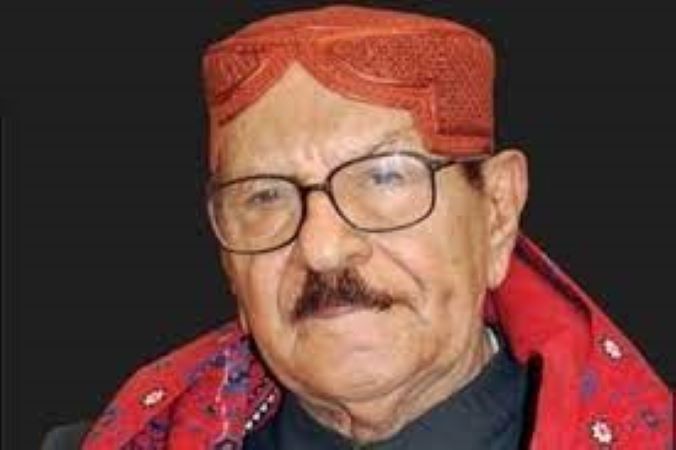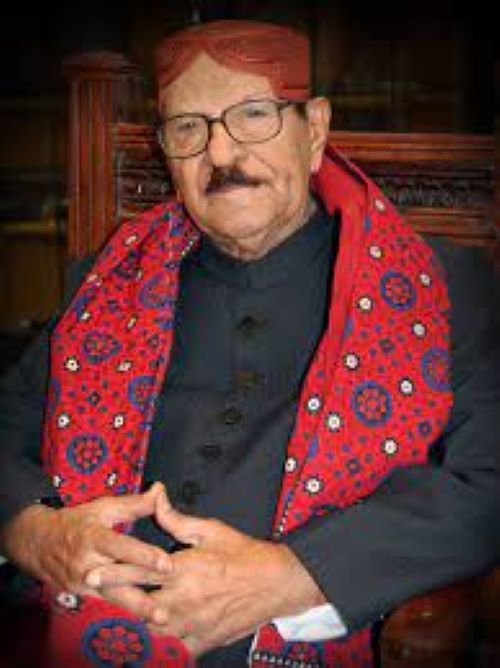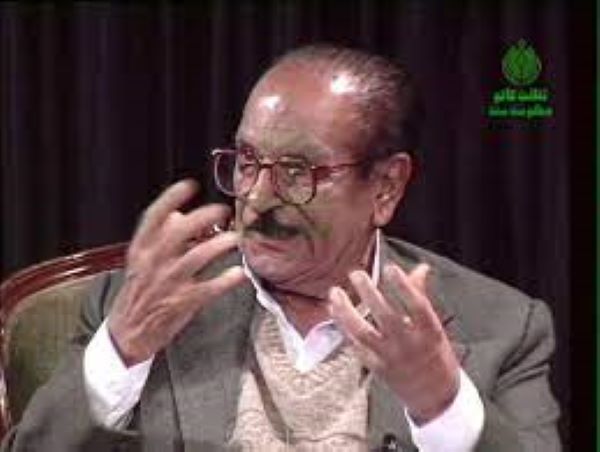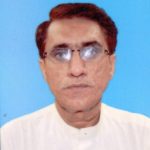
Dr. N.A. Baloch was an erudite folklorist, historian, linguist, educationist, and scholar of Sindh and Pakistan
By Muhammad Habib Sanai
Dr. N.A. Baloch (Dr. Nabi Bux Baloch, 16 December 1917 – 6 April 2011), an erudite folklorist, historian, linguist, educationist, and scholar of Sindh and Pakistan, was born in a hamlet known as Jaffar Khan Leghari of District Sanghar. When he was only six months old, his father breathed his last. His father has however urged his brother and father to educate his son. To fulfill the wishes of his late father, his uncle got him admitted to a school located in a nearby village. As he was a brilliant student, therefore one visiting education officer advised his uncle to get him enrolled in any High School for further studies. At that time, a nearby Middle School was 13 miles away from his village, and to get to the High School, after undertaking a train journey, one has to either walk or travel in an oxen cart for 14 miles.
After completing his primary schooling, he went to Madarassa High School, Naushehro Feroze, headed by the prominent educationist and Scholar Mr. Osman Ali Ansari. During his stay at this School, he dabbled in poetry and was made Secretary of the Poetry Club by his Arabic Teacher Makhdoom Ameer Ahmed, who later translated some of the most important Persian History books into Sindhi, which were edited by Dr. Baloch. He passed the examination of matriculation in 1936 and secured second position amongst Muslim students.
 For some time, he studied at D.J Science College, Karachi, but got fed up, so he went to Junagarh to join Bahauddin College, which offered free education, lodging, and boarding to Muslim students. He remained there up to 1941 and acquired the degree of BA with 1st class third position. As he had become a devoted activist of the Khaksaar Movement of Allama Mashraqi, therefore, he was almost denied admission in Masters to that College. As such, for post-graduation, he joined Aligarh University. He not only got the degree of MA in Arabic in 1943 but also Bachelor in Law from that University around 1945. He also got approved topic of Sindh under Arab Administration for his Ph.D. dissertation to be written in Arabic under the guidance of Dr. Abdul Aziz Al-Memoni, father of renowned writer and translator Dr. Umar Memon, and spent a few years in research but due to some untoward events, he could not proceed further. However, this research helped him later on in writing and editing historical books.
For some time, he studied at D.J Science College, Karachi, but got fed up, so he went to Junagarh to join Bahauddin College, which offered free education, lodging, and boarding to Muslim students. He remained there up to 1941 and acquired the degree of BA with 1st class third position. As he had become a devoted activist of the Khaksaar Movement of Allama Mashraqi, therefore, he was almost denied admission in Masters to that College. As such, for post-graduation, he joined Aligarh University. He not only got the degree of MA in Arabic in 1943 but also Bachelor in Law from that University around 1945. He also got approved topic of Sindh under Arab Administration for his Ph.D. dissertation to be written in Arabic under the guidance of Dr. Abdul Aziz Al-Memoni, father of renowned writer and translator Dr. Umar Memon, and spent a few years in research but due to some untoward events, he could not proceed further. However, this research helped him later on in writing and editing historical books.
Then he came back to Sindh and joined the newly established Sindh Muslim College, Karachi as a Professor of Arabic. After a few months, he received a government scholarship for doing M.Ed. and Ph.D. in the USA. In 1946, he got enrolled in Columbia University for his studies. He completed his Ph.D. in 1949 and the title of his dissertation was “A National System of Education and the Education of Teachers”.
He was offered a job in United Nations but came back to Pakistan and for almost one year, he remained jobless. During that period, he traveled far and wide and collected material for essays and books which he wrote later on. Soon he joined the Ministry of Information as OSD. In this capacity, he also started the publication of the Sindhi monthly entitled Naeen Zindgi by the Information Department. This periodical under the editorship of Molana Abdul Wahid Sindhi contributed hugely to the development of modern Sindhi literature.
When Allama I.I. Qazi became Vice-Chancellor of Sindh University, which, at that time was the only examination body. He wanted to make it a teaching University, therefore, he asked various learned persons including Dr. Baloch to join Sindh University. Dr. Baloch joined University as a Professor of Education and was tasked to establish the Department of Education. This Department was later on upgraded to the Institute level. He also established Sindhi Department. He is also the founder of Sindhi Academy, which is now known as the Institute of Sindhiology.
He worked as Vice-Chancellor of Sindh University from 1973 to 1976. Then he was posted as OSD / Federal Secretary of the Ministry of Education and later in the Ministry of Culture and Information. In 1980, he was appointed founding Vice-Chancellor of International Islamic University, Islamabad, and worked there up to 1983. During the same period, he also worked as Chairman/Director, National Commission on History, Research and Culture. From 1983 to 1989 he worked as Advisor to National Hijra Council, Islamabad. In 1991, he was appointed as Chairman of, Sindhi Language Authority for three years.
He wrote his first book entitled Donkey along with his class fellow Mr. Gul Mohammad Shaikh, which was published in 1946. It was a political satire. His second book entitled Belain ja Bol (Compositions of folk poets of Las Bela) was published in 1951.
 When he was made a member of the Sindhi Adabi Board, he prepared some important schemes. His first major scheme was the preparation of the Comprehensive Sindhi to Sindhi Dictionary. For this purpose, an office was also established on the premises of Sindh University. Dr. Baloch used to attend this office during the evenings after performing routine duties at University in the morning to supervise the collection or gathering of material for the dictionary. The first volume of that Dictionary was published in 1960 and the last fifth one was published in 1988. Later on, these volumes were revised and published in three volumes by Sindhi Language Authority. As a lexicographer, he also compiled and edited one volume of the Sindhi to Sindhi dictionary and also a dictionary of difficult words and terms used in the poetry of Shah Abdul Latif.
When he was made a member of the Sindhi Adabi Board, he prepared some important schemes. His first major scheme was the preparation of the Comprehensive Sindhi to Sindhi Dictionary. For this purpose, an office was also established on the premises of Sindh University. Dr. Baloch used to attend this office during the evenings after performing routine duties at University in the morning to supervise the collection or gathering of material for the dictionary. The first volume of that Dictionary was published in 1960 and the last fifth one was published in 1988. Later on, these volumes were revised and published in three volumes by Sindhi Language Authority. As a lexicographer, he also compiled and edited one volume of the Sindhi to Sindhi dictionary and also a dictionary of difficult words and terms used in the poetry of Shah Abdul Latif.
In the second scheme named as Folklore and literature Project, it was proposed to collect and publish works about the Fables and fairy tales, Pseudo-historical Romances, Tales of historical nature, folk poetry, and songs, dirges over dead, riddles, proverbs, folk customs and superstitions in forty volumes. However, 42 volumes were collected, compiled, and edited by him, and published by Sindhi Adabi Board from 1959 to the early eighties. He used to write English prefaces in these volumes, which have been published in a separate anthology as Folklore of Sindh by the Sindh Culture Department in 2014.
Despite his gigantic contribution to Sindhi literature, he is criticized especially on account of his work on Shah Abdul Latif with a special bent of mind, and also it is alleged that he exaggerated the achievements of the Talpur dynasty
His third major scheme was the preparation of a comprehensive edition of Shah jo Risalo free from extraneous poetry included in other editions. Under this scheme, he compiled and edited ten volumes. His outright exclusion of the melody of Kedaro as extraneous poetry has invited severe criticism from some circles. Besides Shah Abdul Latif, he has also compiled and edited poetry anthologies of other classical poets of Sindh including Qazi Qazan, Khalifo Nabi Bakhsh, Shah Lutfullah Qadri, and a few others, and wrote a comprehensive introduction to all volumes.
As a historian, he supervised and edited Sindhi translations of three important Persian books, viz., Fatehnama/Chachnama, Tareekh Masoomi, Tuhfat al kiram. He also edited and wrote a comprehensive introduction to the English translation of Chachnama. Besides, he has written more than a hundred research essays mostly on the history of Sindh. His English writings have been collected and published in some volumes. In Sindhi, he has compiled and published ten volumes under the title Rehaan Heeran Khhanh, (Meetings like diamonds) wherein he has presented the material, he had gathered in the meetings and conversations held with renowned folk poets (Sugars), wise old men, and professionals of diverse fields, during the period of fifty years from 1950 to 2000 on a variety of topics such as music, ethnology, astrology, animal sciences, botany, etc. Also, he has authored books on the History of Sindhi Language and Literature and the History of Music.
As an Advisor to National Hijra Council, Islamabad, he devised a plan to publish one hundred greatest books of Islamic civilization written in Arabic or Persian with English Translation and a comprehensive Introduction. As a first step, a book entitled Great Books of Islamic Civilizations containing brief introductions of 76 books out of one hundred books was published. In his tenure, he succeeded to publish only five books.
Along with Sindhi and English, he also wrote and edited books in Urdu, Persian, and Arabic. He was a person of multifarious pursuits, whose indelible imprints upon the Sindhi Scholarship will remain unmatched for a long.
Despite his gigantic contribution to Sindhi literature, he is criticized especially on account of his work on Shah Abdul Latif with a special bent of mind, and also it is alleged that he exaggerated the achievements of the Talpur dynasty.
____________________
 Muhammad Habib Sanai is based in Hala town of Sindh. He is a freelance writer and contributes his research-based articles to various newspapers and other publications.
Muhammad Habib Sanai is based in Hala town of Sindh. He is a freelance writer and contributes his research-based articles to various newspapers and other publications.
[…] Read: Dr. NA Baloch – An Iconic Scholar of Sindh […]